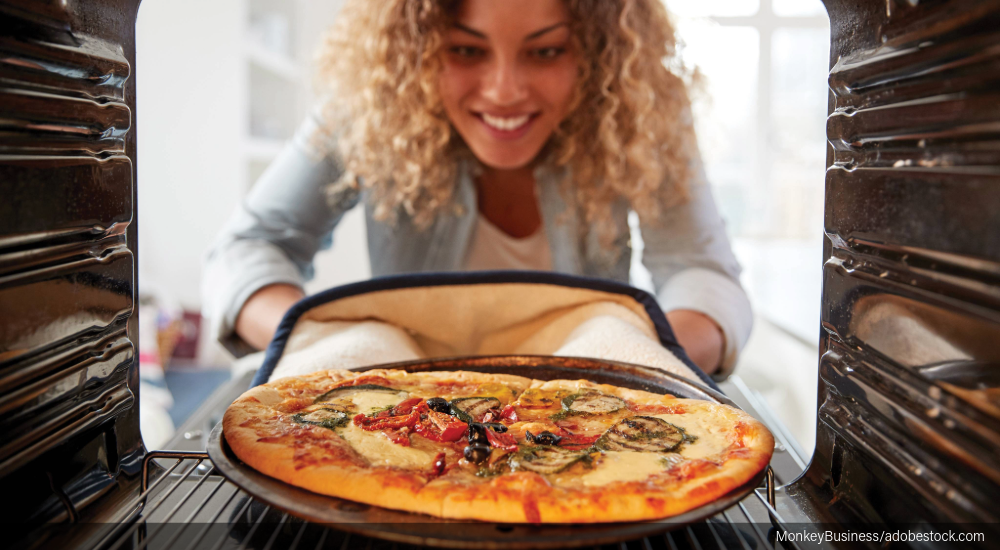Don’t LetYour Customers Wing It; Provide Reheating Instructions
Are you offering takeout and delivery? If not, you might be leaving untold amounts of money on the table. Pizza is one of the most takeout-friendly foods, but we all know what happens as soon as the lid closes. No matter how many ventilation holes there are in a box, a pizza that has been sitting with the lid closed for even a minute is a completely different pizza than the one served fresh in-house.
For some pizzerias, take-out boxes are a hard no; their pizzas only are meant to be enjoyed immediately. This approach works for some concepts, but others rely on revenue from to-go orders. So, are you leaving your customers to fend for themselves when that pizza leaves your doors, or are you coaching them about how to reheat and enjoy your pizza to its fullest at home?
Steam: the Enemy of Pizza
When a pizza sits in a box with the lid closed, steam from the pizza is trapped inside. Most boxes offer ventilation holes, but they’re usually minimal, and people often forget to pop them open. If you have a stack of pizza boxes, those holes can end up blocked, leaving the steam with nowhere to go.
Americans are accustomed to receiving their pizzas cut into slices – be it square or triangle. While this gives us ease of serving and eating, those cuts are part of the problem. All the moisture on top of the pizza – whether from your sauce, cheese or toppings – needs somewhere to go. Once the pizza has been cut, there’s nowhere for steam to go but down, and all those tasty juices seep into your crust.
In this instance, I’d recommend first having a box insert of some kind to sit between the pizza and the box and help to absorb any moisture. This is even more necessary for pies with more toppings. We’ve all experienced having the underside of the pizza box completely soaked through by the time you’ve gotten it home. The soggy box is completely avoidable and can even be incorporated into the cost of the pizza – or included in a box charge, if you’re worried about the additional cost.
Reheating Instructions
Once the pizza is home, are you supplying reheating instructions or expecting your customers to wing it? In a perfect world, we would serve all pizzas uncut so our patrons could reheat them at home, cut and serve and have a near-restaurant experience every time. But let’s be honest, this isn’t happening any time soon.
Since we will have to continue to wait for that day, teaching customers how to reheat their pizzas as quickly and as easily as possible is the way to go. Some operators print pizza boxes or receipts with QR codes that lead to a reheating video as an easy resource. These quick videos could serve multiple purposes: If they are linked to your website or social media, then you gain traffic where you wouldn’t have before, and the video is giving a clear visual explanation about how you want your customers to reheat and enjoy your product.
For those that do not want to go the video route, written directions are a must. You want them to be short and sweet but not so dumbed down that you might miss a step that seems obvious to you but is not to the consumer. Let’s be honest with ourselves, we’ve all pushed on a pull door at least once in our lives.
Test Reheating Instructions
Before handing out any directions to the masses, I suggest a test subject. Pick a loyal customer or a friend to test your directions and take some photos for you. Picking a loyal customer helps ingratiate them further into your pizza family and makes them feel like you value them beyond a customer. You also will gain a more honest experience with constructive feedback.
Now, what should directions look like? What important details should they contain? The first thing to remember is the average customer does not have pizza-specific equipment. Most customers are just working with a standard oven, pans and basic utensils.
You want to think about cooking temperature and surface contact. What temp should the oven be preheated to – and for how long? Most home ovens are going to reach 500 F-550 F. Do your customers even need an oven, or can reheating be done on a stovetop in a pan? The microwave is death to pizza, so I do not recommend advising customers to reheat in a microwave.
For those using an oven, a pizza stone or steel would be ideal, as they conduct heat better than a sheet pan, but not everyone has them, and they require a longer preheat to ensure the surface is hot. Most sheet pans for home use are made of aluminum and are poor conductors of surface heat needed for crisping slices.
Stovetop Reheat
For those opting to use the stovetop method, a good skillet is great. I love a good cast iron pan, as they hold heat tremendously well and are more even. I do not recommend a nonstick pan, but use what you’ve got. You’ll want a lid for this method, as you want to trap some steam in the pan so the ingredients on top have some moisture bouncing back down while the bottom is crisping.
For the stovetop method, I recommend preheating the chosen surface but starting at a medium heat to better control the process. Too hot too fast means burnt bottoms and dry or cold tops.
Adding a few droplets of water into the pan and then placing the lid on to help trap the moisture midway through the reheat helps soften the top ingredients and ensure the slice heats all the way through. You’ll only need the lid for a minute or two, as you don’t want soggy toppings.
Reheating in the Oven
To reheat pizza in the oven, space out the slices and heat them for a few minutes or until the cheese is melty again. Visual cues are just as important as timing.
Ultimately, reheating pizza is the best way to get the crisp back and create a more favorable experience, but remember: Customers do not always want to go the distance for amazing pizza, so keep it short and sweet but hit all the highlights.
Laura Meyer is the owner of Pizzeria da Laura in Berkeley, California.
 Read the November 2025 Issue of Pizza Today Magazine
Read the November 2025 Issue of Pizza Today Magazine
This month, we are diving deep on all things cheese. Learn how the fluctuating commodities market can impact the price you pay for mozzarella and other block cheeses. Then, find out how operators are using craft beer cheddar, gorgonzola and plant-based cheeses made from cashews, coconuts, peas and other bases to create pizzas that are visually and gastronomically stunning. Round out your education for the month by brushing up on pizzeria art, SOPs and winter squash.
Check out the full Digital Edition – Pizza Today November 2025.



